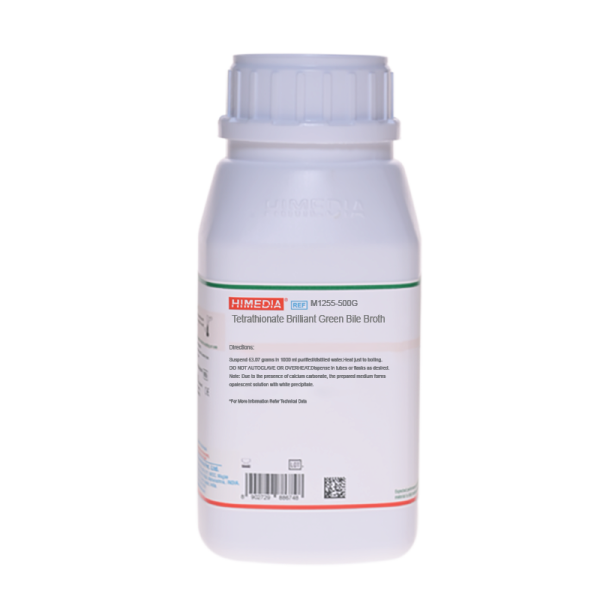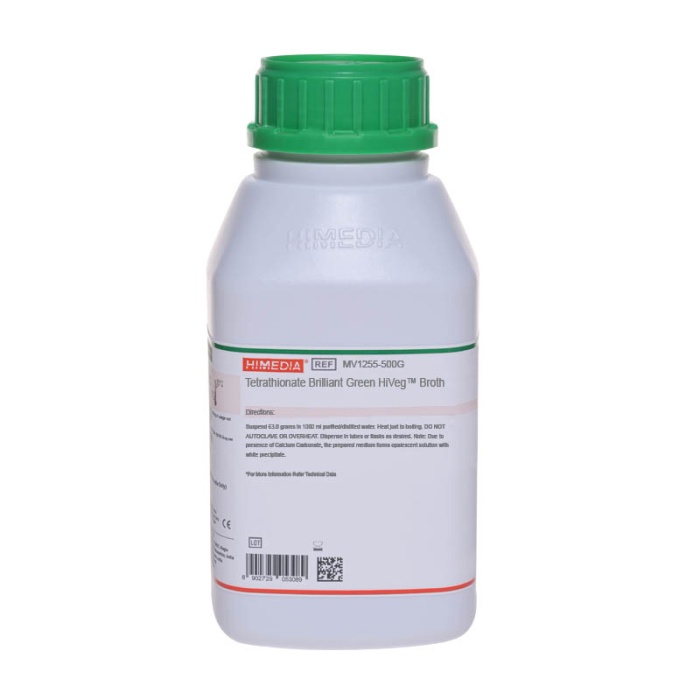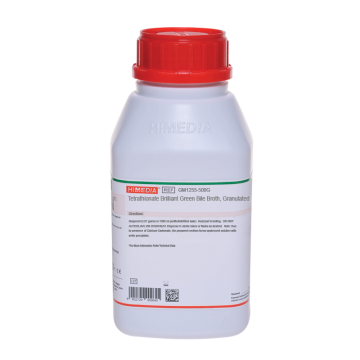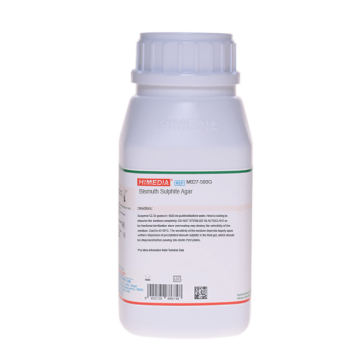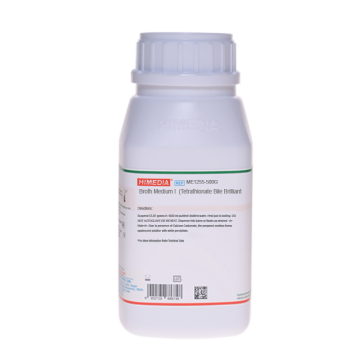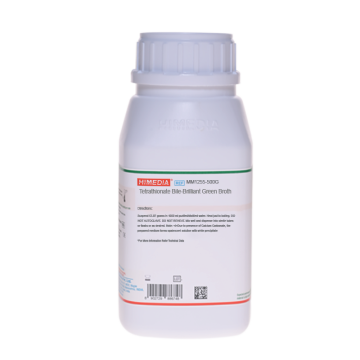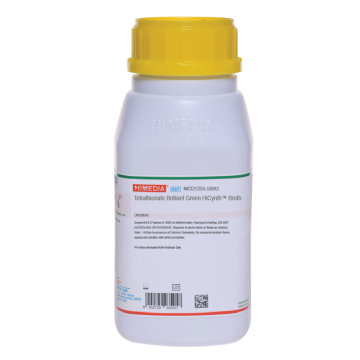 Your enquiry has been submitted
Your enquiry has been submitted
Tetrathionate Brilliant Green Bile Broth
Intended Use
Recommended for isolation and identification of Salmonellae.
Composition
| Ingredients | g/L |
|---|---|
| Peptone | 8.600 |
| Bile | 8.000 |
| Sodium chloride | 6.400 |
| Calcium carbonate | 20.000 |
| Potassium tetrathionate | 20.000 |
| Brilliant green | 0.070 |
| Final pH (at 25°C) | 7.0±0.2 |
**Formula adjusted, standardized to suit performance parameters
Directions
Suspend 63.07 grams in 1000 ml purified / distilled water. Heat just to boiling. DO NOT AUTOCLAVE OR REHEAT.
Dispense into sterile tubes or flasks as desired.
Note: Due to the presence of calcium carbonate, the prepared medium forms opalescent solution with white precipitate.
Principle And Interpretation
Salmonella are gram-negative, facultatively anaerobic, non-sporulating, non-motile rods in the family Enterobacteriaceae.
They are widely distributed in animals affecting mainly the stomach and the intestines. These organisms are difficult to differentiate biochemically from Escherichia coli. Tetrathionate Broth was originally described by Mueller (7) and later modified by Kauffman (4,5). Tetrathionate Brilliant Green Bile Broth is used as an enrichment medium for Salmonella.
Enrichment broth is usually recommended to facilitate the recovery of small numbers of Salmonella species (4). Tetrathionate Brilliant Green Bile Broth is also mentioned in I.P. (1) for isolation and identification of Salmonella species from foods, water and other materials of sanitary importance.
Peptone in the medium provides nitrogenous and carbonaceous compounds, long chain amino acids, vitamins and nutrients for growth of Salmonellae. Brilliant green and bile inhibit both gram-positive as well as some selected gram-negative organisms. Potassium tetrathionate inhibits normal flora of faecal specimens. Sodium chloride helps in maintaining osmotic equilibrium.
After incubation, streak the culture from Tetrathionate Brilliant Green Bile Broth (M1255) onto differential medium for isolation and identification.
Tetrathionate Brilliant Green Bile Broth is not suitable for growth of Salmonella Typhi and Salmonella Paratyphi (6).
Type of specimen
Food samples
Specimen Collection and Handling
For food samples, follow appropriate techniques for sample collection and processing as per guidelines (9).
After use, contaminated materials must be sterilized by autoclaving before discarding.
Warning and Precautions
Read the label before opening the container. Wear protective gloves/protective clothing/eye protection/face protection. Follow good microbiological lab practices while handling specimens and culture. Standard precautions as per established guidelines should be followed while handling specimens. Safety guidelines may be referred in individual safety data sheets.
Limitations
- For further confirmation, streak the enriched cultures after incubation, on plates of Brilliant Green Agar (M016), MacConkey Agar (M081) and Bismuth Sulphite Agar (M027).
Performance and Evaluation
Performance of the medium is expected when used as per the direction on the label within the expiry period when stored at recommended temperature.
Quality Control
Appearance: Light yellow to pale green homogeneous free flowing powder
Colour and Clarity of prepared medium: Bluish green coloured opalescent solution with white precipitate.
Reaction: Reaction of 6.3% w/v aqueous solution at 25°C. pH: 7.0±0.2
pH: 6.80-7.20
Cultural Response: Cultural characteristics observed when subcultured on MacConkey Agar (M082) after an incubation at 35-37°C for 18-24 hours.
| Organism | Inoculum (CFU) | Growth | Recovery | Colour of colony |
|---|---|---|---|---|
| Escherichia coli ATCC 25922 (00013*) | 50-100 | fair | 20-30% | pink to red with bile precipitate |
| Salmonella Typhi ATCC 6539 | 50-100 | luxuriant | >=50% | colourless |
| Salmonella Typhimurium ATCC 14028 (00031*) | 50-100 | luxuriant | >=50% | colourless |
| Salmonella Enteritidis ATCC 13076 (00030*) | 50-100 | luxuriant | >=50% | colourless |
| Staphylococcus aureus subsp. aureus ATCC 25923 (00034*) | >=10⁴ | inhibited | 0% | |
| Staphylococcus aureus subsp. aureus ATCC 6538 (00032*) | >=10⁴ | inhibited | 0% | |
| Escherichia coli ATCC 8739 | 50-100 | fair | 20-30% | pink to red with bile precipitate |
Key: *Corresponding WDCM numbers.
Storage and Shelf Life
Store between 10-30°C in a tightly closed container and the prepared medium at 15-30°C. Use before expiry date on the label. On opening, product should be properly stored dry, after tightly capping the bottle in order to prevent lump formation due to the hygroscopic nature of the product. Improper storage of the product may lead to lump formation. Store in dry ventilated area protected from extremes of temperature and sources of ignition Seal the container tightly after use. Product performance is best if used within stated expiry period.
Disposal
User must ensure safe disposal by autoclaving and/or incineration of used or unusable preparations of this product. Follow established laboratory procedures in disposing of infectious materials and material that comes into contact with sample must be decontaminated and disposed of in accordance with current laboratory techniques (2,3).
Reference
- Indian Pharmacopoeia, 2022, Indian Pharmacopoeia Commission, Ministry of Health and Family Welfare Government of India.
- Isenberg, H.D. Clinical Microbiology Procedures Handbook 2nd Edition.
- Jorgensen, J.H., Pfaller, M.A., Carroll, K.C., Funke, G., Landry, M.L., Richter, S.S and Warnock., D.W. (2015) Manual of Clinical Microbiology, 11th Edition. Vol. 1.
- Kauffman F., 1930, Hyg. Abt. I. Orig., 113, 148.
- Kauffman F., 1935, Z. Hyg. Infektionskr., 117, 26.
- MacFaddin J. F., 1985, Media for Isolation-Cultivation-Identification-Maintenance of Medical Bacteria, Vol. I, Williams and Wilkins, Baltimore.
- Mueller L., 1923, C. R. Soc. Biol., (Paris), 89, 434.
- Murray P. R., Baron J. H., Pfaller M. A., Jorgensen J. H. and Yolken R. H., (Ed.). 2003, Manual of Clinical Microbiology, 8th Ed., American Society for Microbiology, Washington, D.C.
- Salfinger Y., and Tortorello M.L., 2015, Compendium of Methods for the Microbiological Examination of Foods, 5th Ed., American Public Health Association, Washington, D.C.
| Product Name | Tetrathionate Brilliant Green Bile Broth |
|---|---|
| SKU | M1255 |
| Product Type | Regular |
| Physical Form | Powder |
| Origin | Animal |
| Packaging type | HDPE |
| References | 1. Indian Pharmacopoeia, 1996, Ministry of Health and Family Welfare, Govt. of India 2.Isenberg, H.D. Clinical Microbiology Procedures Handbook 2nd Edition |
| Customized Product Available | No |



